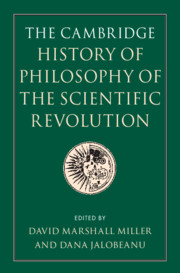34 results
Preface
-
- Book:
- The Cambridge History of Philosophy of the Scientific Revolution
- Published online:
- 14 January 2022
- Print publication:
- 06 January 2022, pp xiii-xiv
-
- Chapter
- Export citation
Introduction - The Disciplinary Revolutions of Early Modern Philosophy and Science
-
-
- Book:
- The Cambridge History of Philosophy of the Scientific Revolution
- Published online:
- 14 January 2022
- Print publication:
- 06 January 2022, pp 1-12
-
- Chapter
- Export citation
Part III - Problems and Controversies
-
- Book:
- The Cambridge History of Philosophy of the Scientific Revolution
- Published online:
- 14 January 2022
- Print publication:
- 06 January 2022, pp 313-452
-
- Chapter
- Export citation
Bibliography
-
- Book:
- The Cambridge History of Philosophy of the Scientific Revolution
- Published online:
- 14 January 2022
- Print publication:
- 06 January 2022, pp 453-523
-
- Chapter
- Export citation
Contributors
-
- Book:
- The Cambridge History of Philosophy of the Scientific Revolution
- Published online:
- 14 January 2022
- Print publication:
- 06 January 2022, pp ix-xii
-
- Chapter
- Export citation
Tables and Figures
-
- Book:
- The Cambridge History of Philosophy of the Scientific Revolution
- Published online:
- 14 January 2022
- Print publication:
- 06 January 2022, pp viii-viii
-
- Chapter
- Export citation
Copyright page
-
- Book:
- The Cambridge History of Philosophy of the Scientific Revolution
- Published online:
- 14 January 2022
- Print publication:
- 06 January 2022, pp iv-iv
-
- Chapter
- Export citation
17 - Galileo’s Sidereus Nuncius and Its Reception
- from Part III - Problems and Controversies
-
-
- Book:
- The Cambridge History of Philosophy of the Scientific Revolution
- Published online:
- 14 January 2022
- Print publication:
- 06 January 2022, pp 315-330
-
- Chapter
- Export citation
Contents
-
- Book:
- The Cambridge History of Philosophy of the Scientific Revolution
- Published online:
- 14 January 2022
- Print publication:
- 06 January 2022, pp v-vii
-
- Chapter
- Export citation
Index
-
- Book:
- The Cambridge History of Philosophy of the Scientific Revolution
- Published online:
- 14 January 2022
- Print publication:
- 06 January 2022, pp 524-536
-
- Chapter
- Export citation
Part I - The Disciplines
-
- Book:
- The Cambridge History of Philosophy of the Scientific Revolution
- Published online:
- 14 January 2022
- Print publication:
- 06 January 2022, pp 13-146
-
- Chapter
- Export citation
Part II - Disciplinary Activities
-
- Book:
- The Cambridge History of Philosophy of the Scientific Revolution
- Published online:
- 14 January 2022
- Print publication:
- 06 January 2022, pp 147-312
-
- Chapter
- Export citation

The Cambridge History of Philosophy of the Scientific Revolution
-
- Published online:
- 14 January 2022
- Print publication:
- 06 January 2022
Representing Space in the Scientific Revolution - Half title page
-
- Book:
- Representing Space in the Scientific Revolution
- Published online:
- 05 August 2014
- Print publication:
- 07 August 2014, pp i-ii
-
- Chapter
- Export citation
Representing Space in the Scientific Revolution - Title page
-
-
- Book:
- Representing Space in the Scientific Revolution
- Published online:
- 05 August 2014
- Print publication:
- 07 August 2014, pp iii-iii
-
- Chapter
- Export citation
Figures
-
- Book:
- Representing Space in the Scientific Revolution
- Published online:
- 05 August 2014
- Print publication:
- 07 August 2014, pp x-x
-
- Chapter
- Export citation
Chapter 8 - Conclusion: methodological morals
-
- Book:
- Representing Space in the Scientific Revolution
- Published online:
- 05 August 2014
- Print publication:
- 07 August 2014, pp 212-216
-
- Chapter
- Export citation
Chapter 2 - Pluribus ergo existentibus centris: explanations, descriptions, and Copernicus
-
- Book:
- Representing Space in the Scientific Revolution
- Published online:
- 05 August 2014
- Print publication:
- 07 August 2014, pp 27-63
-
- Chapter
- Export citation
Chapter 1 - Introduction: centers and orientations
-
- Book:
- Representing Space in the Scientific Revolution
- Published online:
- 05 August 2014
- Print publication:
- 07 August 2014, pp 1-26
-
- Chapter
- Export citation
Contents
-
- Book:
- Representing Space in the Scientific Revolution
- Published online:
- 05 August 2014
- Print publication:
- 07 August 2014, pp vii-ix
-
- Chapter
- Export citation



